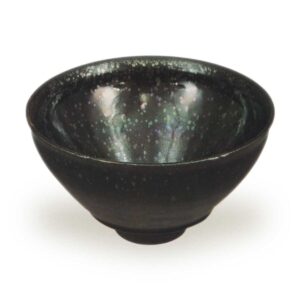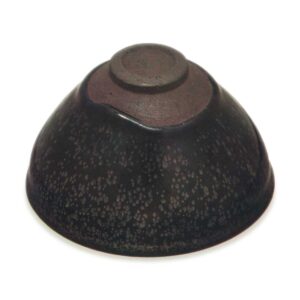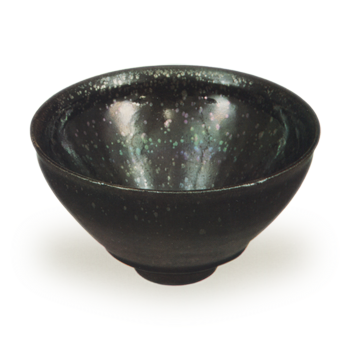

Important Cultural Property
Height: 7.0-7.3 cm
Mouth diameter: 12.3 cm
Outer diameter of base: 3.7 cm
Height: 0.7 cm
This is a yōhen tenmoku, a type of Japanese pottery that was handed down in the Maeda family of Kaga Prefecture. It is said that there have been only six Yōhen types since ancient times, but only four are known today: Inaba Tenmoku (National Treasure, Seikado collection), which belonged to the Inaba family of Yodo; Yōhen, which belonged to the Tokugawa family of Mito (National Treasure, Fujita Museum of Art); Yōhen, which belonged to Ryūkoin in Kyoto (National Treasure); and this bowl. However, they are precious objects that can be found nowhere else in the world except in Japan, and should be called the greatest treasures of Chinese ceramics.
Unlike oil drops, the mystery of why yōhen occurred has yet to be solved. It must have been produced by chance and by fire, but it is not known under what conditions fire can produce such a phenomenon. However, according to the research of Dr. Kazuo Yamazaki, an extremely thin film of only 1/10,000th of a millimeter is applied to the glaze surface, and this thin film breaks down light rays to produce a mysterious seven-color glow. When a thin film forms on the glaze surface, it acts like a prism, breaking up the light rays and producing a rainbow of colors, in the same way as, for example, the wings of an insect, soap bubbles, or oil on water. When the light rays are strong, the glaze shines brightly, and when the light is dull, the yohhen glaze is dull and subdued.
The yōhen inherited from the Maeda family is not as brilliant as the yōhen from Seikado, the Fujita Museum of Art, or Ryūkoin, but when light is shone on the inner surface, blue, green, peach, and purple yōhen appear on the glaze surface, as shown in the illustration, and a mysterious luster is emitted from the jet-black glaze. The outer grains are similar to oil droplets, and some of them emit the same luster as the inner surface, but they are not as brilliant as the inner surface.
If you look closely, you can see that the surface of the glaze is slightly dented only in the area of the yohhen grains. Like oil droplets, these are probably crystals of iron rust that have gathered in the bubbles that form when the glaze is boiled and volatilized, forming a thin film on top of the rust and forming yōhen. The mystery of yōhen is what this film is and how it was formed.
This Yohhen Tenmoku tea bowl, which has been handed down in the Maeda family, is made of a slightly iron-rich clay, and due to the kiln conditions, the clay has a blackish purple, iron-like color. However, this is because the clay has been carbonized or has become blackened due to dirtiness, so the iron content in the clay itself is not as large as it appears.
Although the bowl is thick, the twisted rim is comparatively thin and tightens the bowl. It has a low, small base, and there is a shallow notch within the base. The jet-black glaze is thickly applied up to the waist, and the glaze has flowed down and accumulated thickly especially at the edge of the glaze.
There is a pinhole in the center of the prospect, and two small and large frayed areas on the mouth rim, which have been repaired with lacquer, but the rim is not covered with a wrap.
Inner box, gold-painted nashiko ground, silver-painted characters in the shape of “yohen” by Kobori Enshu
Outer box, paulownia-white wood, cover inscribed “Yohen” (yohen)
The origin of this piece is stated in “Gankan Meimono Ki” and “Kokin Meimono Ruiju” as Matsudaira Hizen no Mamoru, and was later handed down to the Maeda family.
(Later it was handed down to the Maeda family.)



